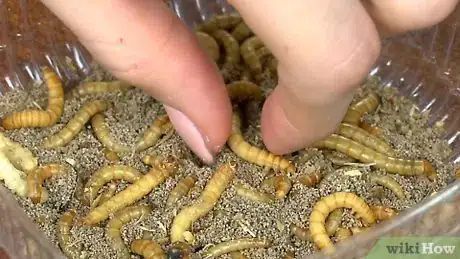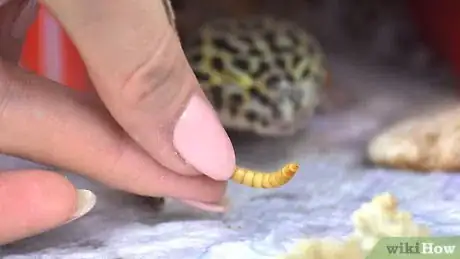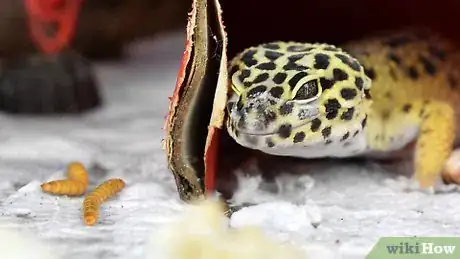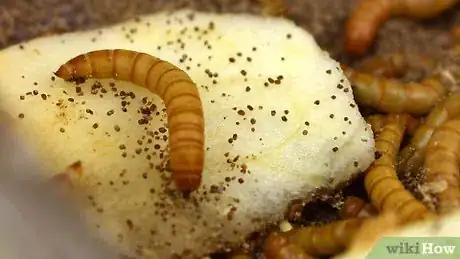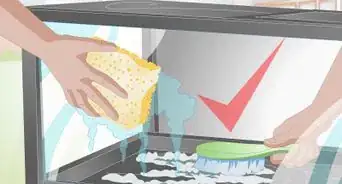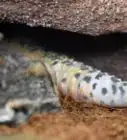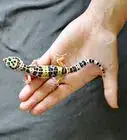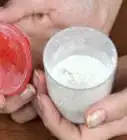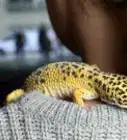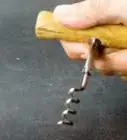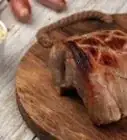This article was co-authored by Audra Barrios. Audra Barrios is a Marine Biologist and owner of Lick Your Eyeballs, a business offering experiemces, reptiles, supplies and plants. With over 15 years of experience, Audra specializes in reptiles and exotic animals, environmental education, marine biology, conservation issues, and animal husbandry. Audra earned a BASc in Marine Biology from the University of California, Santa Cruz, and studied Natural Sciences at the College of Marin. She is the founder and Executive Director of Things That Creep, a non-profit dedicated to herptile conservation through education. She has spent the last nine years working as a biologist at the California Academy of Sciences.
This article has been viewed 32,354 times.
Leopard geckos are ground-dwelling lizards that make great pets for both beginner and experienced reptile owners. If you want a great way to bond and play with your gecko at the same time, try feeding it from your hand! But before you jump right in, make sure you know the right way to do it.
Steps
Feeding Your Gecko
-
1Pick up 1 insect to feed your gecko. Always feed your gecko 1 insect at a time. If you're using a cricket, hold it by the back legs. If you're feeding your gecko worms—which don't move around as much—place them down on your body instead of holding them. Regardless, make sure that the lizard is able to reach the food.
- Some crickets cooperate more than others—if the cricket moves around too much, be careful and remember that the legs can come off.
- Don't feed your gecko food wider than the space between its eyes.
-
2Hold the food 1 to 3 inches (2.5 to 7.6 cm) in front of your gecko to eat. Most geckos with snap at the food fairly quickly—be sure to hold the food in front of it and give yourself enough space to avoid being bitten. Always face your nails towards the gecko—they're too hard to penetrate and it will let go quickly.[1]
- Keep as still as possible when feeding your gecko.
- Use tongs if you'd like to avoid using your fingers.
- If your gecko has a tendency to nip at you, always hold the food between your thumb and forefinger from the back.
Advertisement -
3Watch for your gecko's intense predatory stare. When your gecko is about the bite, it will look really concentrated on the target and possibly crouch—this means it is interested and will probably eat it.[2]
- If your gecko walks away, try feeding it later on. Don't force-feed it or you might harm its digestive system.
-
4Make your gecko work for its food. Move the food around and make your gecko work for it. It's important to make sure it doesn't get bored or lazy or it will be understimulated.[3]
- Be sure to let your gecko chase and hunt its food sometimes.
-
5Wait until the gecko finishes eating and remove leftovers.[4] If you put your hand near your gecko while it's eating it may bite your hand. Once it's done, remove any leftovers and throw them away or save them for later.
- Place live leftovers back into its storage container.
-
6Hand-feed your gecko from your palm when it's more than 6 in (15 cm) long. It's not recommended to handle leopard geckos regularly until they reach the appropriate size. Once they're large enough, start sitting on the floor and letting them crawl into your loose fingers and over your hands for about 10 to 15 minutes daily. Once they're comfortable enough that you can handle them, you can start hand-feeding as they sit in your palm.[5]
- Never grab your gecko's tail.
Preparing Food for Your Gecko
-
1Purchase live insects to feed your gecko.[6] Mealworms or crickets are the best choices for daily gecko food. Dubia Roaches, phoenix worms, silkworms, and hornworms can also be added to their diet.
- Don't feed your gecko pinky mice, plants, or vegetables.
- Feed your geckos superworms or wax worms once a week if you'd like.
- Make sure the insects are no bigger than the width of your gecko's head.
-
2Coat your insects with vitamins a week prior to feeding your gecko.[7] To provide your gecko with nutrients, lightly coat the insects with calcium powder 3 times per week, a mix of calcium powder and vitamin D3 2 times a week, and a mineral supplement 1 time per week. Place the dusting powder in a deep tin can or plastic bag along with your insects and shake it up.[8]
- Purchase vitamin powders from health and fitness stores or online suppliers.
- Follow this schedule for at least 1 week before feeding the insects to your gecko.
-
3Gut-load your insects for at least 12 hours before feeding your gecko. Gut-loading refers to the process of feeding your insects a nutritious diet that can be passed on to your gecko. To gut-load your insects, get a tub of gut-load diet and place them inside of it. You should also add a piece of potato to the tub so the insects have access to water.[9]
- Buy chick, hog mash, or commercial gut-load diets from a feed store. Carrots, leafy greens, fruits, and oats/bran are also great.
Community Q&A
-
QuestionHow much does a leopard gecko need to eat?
 Audra BarriosAudra Barrios is a Marine Biologist and owner of Lick Your Eyeballs, a business offering experiemces, reptiles, supplies and plants. With over 15 years of experience, Audra specializes in reptiles and exotic animals, environmental education, marine biology, conservation issues, and animal husbandry. Audra earned a BASc in Marine Biology from the University of California, Santa Cruz, and studied Natural Sciences at the College of Marin. She is the founder and Executive Director of Things That Creep, a non-profit dedicated to herptile conservation through education. She has spent the last nine years working as a biologist at the California Academy of Sciences.
Audra BarriosAudra Barrios is a Marine Biologist and owner of Lick Your Eyeballs, a business offering experiemces, reptiles, supplies and plants. With over 15 years of experience, Audra specializes in reptiles and exotic animals, environmental education, marine biology, conservation issues, and animal husbandry. Audra earned a BASc in Marine Biology from the University of California, Santa Cruz, and studied Natural Sciences at the College of Marin. She is the founder and Executive Director of Things That Creep, a non-profit dedicated to herptile conservation through education. She has spent the last nine years working as a biologist at the California Academy of Sciences.
Marine Biologist & Reptile Specialist An adult leopard gecko will need to eat about 8-12 insects every other day.
An adult leopard gecko will need to eat about 8-12 insects every other day. -
QuestionHow do I get my leopard gecko to trust me?
 Community AnswerFeed it mealworms out of your hand. Hold steady and don't be jumpy. Don't grab the gecko; allow it to walk on your hand and back off. Do this a few times, and it should begin to trust you.
Community AnswerFeed it mealworms out of your hand. Hold steady and don't be jumpy. Don't grab the gecko; allow it to walk on your hand and back off. Do this a few times, and it should begin to trust you. -
QuestionHow do I get my gecko to not hate me?
 Community AnswerHandling your leopard gecko daily acclimates it to being around you and builds trust between you. Do this for a short amount of time each day and eventually your gecko will be eating out of your hand.
Community AnswerHandling your leopard gecko daily acclimates it to being around you and builds trust between you. Do this for a short amount of time each day and eventually your gecko will be eating out of your hand.
References
- ↑ https://youtu.be/WtcH04lw5lc?t=49
- ↑ http://www.reptilesmagazine.com/Care-Sheets/Lizards/Leopard-Gecko/
- ↑ https://youtu.be/37XjBMudxUs?t=222
- ↑ Audra Barrios. Marine Biologist & Reptile Specialist. Expert Interview. 18 August 2020.
- ↑ http://www.reptilesmagazine.com/Care-Sheets/Lizards/Leopard-Gecko/
- ↑ Audra Barrios. Marine Biologist & Reptile Specialist. Expert Interview. 18 August 2020.
- ↑ Audra Barrios. Marine Biologist & Reptile Specialist. Expert Interview. 18 August 2020.
- ↑ https://www.petmd.com/reptile/care/caring-baby-gecko
- ↑ http://www.reptilesmagazine.com/Care-Sheets/Lizards/Leopard-Gecko/
About This Article
To feed a leopard gecko from your hand, start by picking up an insect, like a cricket or a worm, and holding it a few inches in front of your gecko. Then, wait for your gecko to notice the food and grab it. If your gecko doesn't seem interested, try moving the food around and getting your gecko to chase it. Once your gecko is finished eating, pick up any leftovers and save them or toss them out. To learn how to prepare food before feeding it to your gecko, scroll down!
